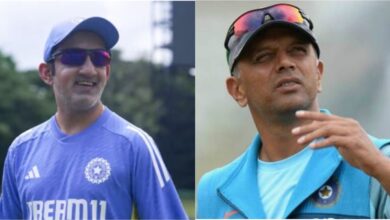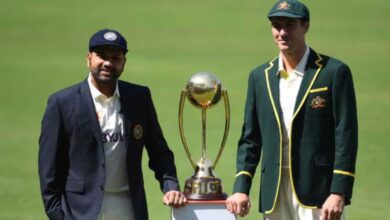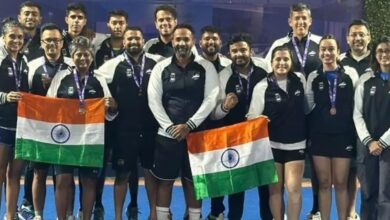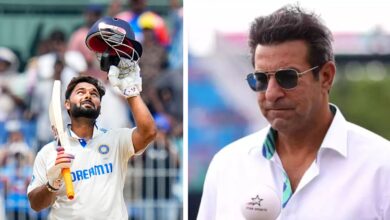John McEnroe gets his revenge

John McEnroe was sitting on a couch 43 stories above Manhattan, his gray curls and sleepy, crinkled eyes betraying every one of his 63 years, some of them hard ones, regaling an awe-struck podcaster with stories of his glory years. His rivalry with Bjorn Borg, his battles with chair umpires and his own demons.
The awe-struck podcaster was Kevin Garnett, the NBA champion, Olympic gold medal and 15-time NBA All-Star who is 17 years younger than McEnroe. Garnett was 8 years old when McEnroe won his last Grand Slam singles title in 1984.
Somehow, that does not matter, not even a little bit.
Thirty years after McEnroe played his last match at the U.S. Open, the irascible kid from Queens, the notorious hothead who griped and cussed and kicked his way across the hallowed grass of Wimbledon and every other tennis court, his star has barely faded. It is especially bright during the U.S. Open. He is the leading voice of the tournament on ESPN, the subject of a new documentary, even the narrator and superego of a lovesick and unathletic teenage Indian American girl with a hot temper on Mindy Kaling’s comedy “Never Have I Ever.”
The staying power is sweet revenge for the man whom much of tennis officialdom once viewed as toxic to their genteel game.
“Maybe I wasn’t so bad after all,” McEnroe said during a recent interview at the end of a day that began with an early-morning appearance on “CBS Mornings” and then was jam-packed with chats with journals, including from NPR’s Fresh Air. “These guys who were trying to run me out of the game, maybe they should have been trying to help me instead of hanging me out to dry back in the ‘80s.”
‘The Weight of the Name’
McEnroe won seven Grand Slam singles titles, plenty no doubt, but not as many as Jimmy Connors or Andre Agassi or Ivan Lendl, who each won eight, to say nothing of Borg’s 11, Pete Sampras’ 14 or Rafael Nadal and Novak Djokovic, who have tripled his tally. (Nadal could win a 23rd title at this year’s U.S. Open.)
Yet, McEnroe still looms over his contemporaries, as well as Sampras, who dominated the era just after McEnroe’s. When he walks the grounds of the USTA Billie Jean King National Tennis Center, he is still the quarterback of the varsity football team in the high school cafeteria.
John McEnroe. (FILE)
“Johnny Mac!” fans yell to him as he passes.
He has written two memoirs and been the subject of multiple books. There was a feature film in 2017 about his rivalry with Borg, the Swedish great he vanquished into retirement. The next year came a documentary about him focusing on his brush with perfection in 1984. He has hosted a game show.
When the United States Tennis Association wanted to hold an exhibition to raise money for relief efforts in Ukraine, McEnroe was among its first calls. In that exhibition he played doubles with Nadal, Coco Gauff and Iga Swiatek. All are younger than his oldest child. He’d love a chance to coach Denis Shapovalov of Canada, the flashy and talented, but temperamental, lefty — sound familiar? — but has yet to get the call.
Showtime released the latest documentary last week. The 100-minute film — McEnroe’s longtime agent, Gary Swain, is among the executive producers — is an exploration of his tortured psyche and the seemingly unfulfilled promise of someone who was, for a brief few years a long time ago, both the greatest player who ever lived and perhaps the most miserable.
“The weight of the name ‘McEnroe,’ it’s heavy all across the globe,” said Barney Douglas, who directed the latest documentary.
But why?
McEnroe’s younger brother, Patrick, who also played professional tennis and now commentates (and squabbles) with him on ESPN, thinks he knows the main reason.
“He’s authentic,” Patrick McEnroe said.
Mellowing, Just a Little, With Age
During his playing days, John McEnroe may have been a bit too authentic. Tennis officials and some of their comrades in the news media viewed McEnroe as a menace to the sport. They fined and penalized him and threatened him with suspensions. They derided his penchants for hopping on concert stages to jam with rock stars and indulging in their late-night habits. The British press and the paparazzi hounded him so intensely, especially after his marriage to the movie star Tatum O’Neal, that he skipped Wimbledon at the height of his career.
As it turned out, McEnroe was already where tennis was headed long before it arrived, in good ways and bad.
John McEnroe looks across the court. (AP FILE Photo/Tim Ireland, File)
His game, which was all serve-and-volley all the time, may be completely out of step with nearly every top pro these days. But McEnroe possessed in spades something that continues to separate the best from the merely great — that magical and unteachable touch and creativity that allows a player to blast one shot and feather the next one. He could hit an opponent off the court on one point, then practically catch a 100-mph forehand rocket on his racket on the next one.
He also brought to the court the petulance and nastiness, the relentless attacks on chair umpires and equipment that have become so integral to the modern game, whether it was Serena Williams threatening to shove a ball down a linesman’s throat during her 2009 U.S. Open semifinal against Kim Clijsters, or Nick Kyrgios’ tireless tirades at Wimbledon this year.
Age has mellowed him, though not entirely. His second marriage, 25 years and counting, to Patty Smyth, the lead singer of the rock band Scandal (“I am the warrior….”) and six children have given him some perspective, as well as a few talking-tos when he gets out of line.
But when he hears people saying his serve-and-volley game would not have a prayer against the likes of Djokovic, Nadal and Roger Federer, his voice rises to resemble that unmakable ranting of the man who made chair umpires‘ lives deeply unpleasant.
Dial back time to the peak of his powers, put him on a grass court at maximum intensity, and McEnroe is comfortable in his belief that every so often he could have beaten the modern greats.
“I would have gotten under the skin and made them think,” he said. “Would not have had a winning record, but I would have gotten to them a few times.”
Sounds plausible. In his own way, McEnroe has gotten to all of us — and still does.
This article originally appeared in The New York Times.







